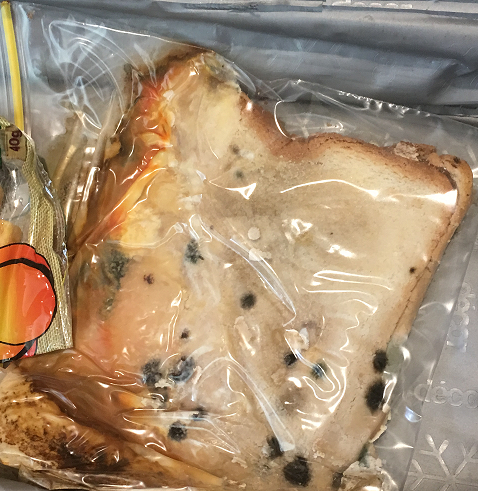Calculus
Chapters
The Product Rule for Derivatives
The Product Rule for Derivatives
Introduction
Calculus is all about rates of change. To find a rate of change, we need to calculate a derivative. In this article, we're going to find out how to calculate derivatives for products of functions.
Let's start by thinking about a useful real world problem that you probably won't find in your maths textbook.
 For the last few weeks, I've noticed
a rather interesting smell coming out of Sam's room. Last week, Sam finished his Year 12 exams and went away on schoolies. I
decided to clean out his room and track down the smell.
For the last few weeks, I've noticed
a rather interesting smell coming out of Sam's room. Last week, Sam finished his Year 12 exams and went away on schoolies. I
decided to clean out his room and track down the smell.
Now, you must bear in mind that Sam's last day of school was at the end of September, and it was now the middle of November. I finally tracked the smell down to Sam's school bag, and noticed the alien life-form on the right inside his lunch box. I'll give you a hint: it wasn't fruit loaf! Needless to say, it ended up in the garbage pretty quick smart.
Sam had decided to eat a chicken burger and chips for lunch on the last day of school instead of the delicious turkey and cheese sandwich that I had packed for him. Perhaps he'd decided to model the growth of the mold colony on his sandwich. He might have come up with an equation like this:
Giving him the benefit of the doubt, I'll assume that Sam did want to model the rate of growth of his mold colony. He would then need to find the derivative of the function \(\text{mold}(t) = t^{2}e^{t + 2}\), and evaluate it at \(t = 20\).
Sounds easy enough, but how do we find the derivative of \(\text{mold}(t)\)?
The Product Rule
Sam's function \(\text{mold}(t) = t^{2} e^{t + 2}\) involves a product of two functions of \(t\). There's a differentiation law that allows us to calculate
the derivatives of products of functions.
Strangely enough, it's called the Product Rule.
So what does the product rule say?
The derivative of \(f(x)g(x)\) is \(f(x)g'(x) + f'(x)g(x)\)
There are two common ways to write the derivative of a function
- If the function is \(f(x)\), then we can write its derivative as \(f'(x)\) using a little ' after the \(f\). We pronounce \(f'(x)\) as "f-dash of \(x\)" or "f-prime of \(x\)"
- If \(y\) is the function of \(x\), then we can also write its derivative as \(\dfrac{dy}{dx}\) and call it "dee-y dee-x".
Now let's differentiate a few functions using the product rule
Example
If \(y = x^3(x^2 + 4)\), what is \( \dfrac{dy}{dx}\)?
There are two ways we could proceed here. One way is to expand the function, to write \(y = x^5 + 4x^3\). We could then use the sum, power and multiplication by a constant rules to find
Of course, this is an article on the product rule, so we should really use the product rule to find the derivative. Let's see if we get the same answer:
We set \(f(x) = x^3\) and \(g(x) = x^2 + 4\). Then \(f'(x) = 3x^2\), and \(g'(x) = 2x\) by the power and sum rules. So,
That looks about right! It wasn't too bad, was it? Let's try another one.
Example
Find the derivative of \(f(x) = x^2 \cos (x)\).
We set \(f(x) = x^2\) and \(g(x) = \cos(x)\). Then \(f'(x) = 2x\), and \(g'(x) = -\sin (x)\) (check these in the rules of derivatives article if you don't remember them). Now use the product rule to find:
Time for another one?
Example
Find the derivative of \(f(x) = x \ln (x) \).
We set \(f(x) = x\) and \(g(x) = \ln(x)\). Then \(f'(x) = 1\), and \(g'(x) = \dfrac{1}{x}\) (check these in the rules of derivatives article if you don't remember them). Now use the product rule to find:
One last example, and then it's time to deal with Sam's mold colony.
Example
Find the derivative of \(f(x) = 17x\tan{x}\).
We set \(f(x) = 17x\) and \(g(x) = \tan(x)\). Then \(f'(x) = 17\), and \(g'(x) = \sec^2(x)\) (check these in the rules of derivatives article if you don't remember them). Now use the product rule to find:
Solving Sam's Problem
Now we know enough to solve Sam's problem. Sam's function was:
and he wants to know the rate of growth of his mold colony after 20 days. So he needs to find the derivative of the mold function (blue cheese?) and plug in \(t = 20\). It looks like a job for the product rule!
Set \(f(t) = t^2\) and \(g(t) = e^{t + 2}\). Then \(f'(t)= 2t\) by the power rule, and \(g'(t) = e^{t + 2}\). So, applying the product rule,
At \(t = 20\):
So the mold is growing at a rate of apporximately \(1.58 \times 10^{12}\) tens of thousands of spores per day.
You know what, Sam? I think it's just as well that I threw that sandwich in the bin!
Description
Calculus is the branch of mathematics that deals with the finding and properties of derivatives and integrals of functions, by methods originally based on the summation of infinitesimal differences. The two main types are differential calculus and integral calculus.
Environment
It is considered a good practice to take notes and revise what you learnt and practice it.
Audience
Grade 9+ Students
Learning Objectives
Familiarize yourself with Calculus topics such as Limits, Functions, Differentiability etc
Author: Subject Coach
Added on: 23rd Nov 2017
You must be logged in as Student to ask a Question.
None just yet!